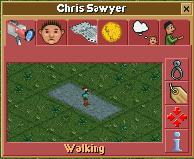 Chris Sawyer. Frequently stops and takes flash photographs.
Chris Sawyer. Frequently stops and takes flash photographs.Return to The Definitive RCT Reference Guide homepage
The whole purpose of Roller Coaster Tycoon is to cause pleasure by satisfying the simple desires of your tiny "guests", while making money {s}. Work to please your guests first, build the dream park second {s}. Do things to make your guests happy, and you'll receive a reward in the form of an increased Park Rating {s} (the Park Rating is a number that reflects the overall perception your guests have of your park). A Guest who stays in the park for only an hour or less, probably did NOT have a great time {s}.
Each guest looks like a young adult male wearing a randomly colored shirt and pants. His machine given name is a consecutive number based on his appearance order on the entrance path to your amusement park. Each guest is also randomly endowed with a fixed Intensity Preference (generated around a game specific low, medium, or high median setting) which draws him towards a similar Intensity ride {m}, a Nausea Susceptibility rating, and a wad of money (actual cash amount will vary within -$10, +$0, +$10, and +$20 of a game/Scenario specific median setting), which helps to make each guest a unique individual. Be careful not to fleece Guests at the Park Entrance by taking most of their money, becuase then they will wander the park looking for something they can afford, and their happieness will decrease in the process (affecting your Park Rating) {s}.
Guests are not invulnerable, and will die if they fall in water or are caught in a ride accident (drowning guests can be saved if you react quick enough with the "pincers"). A guest death will lower your Park Rating. Although the game limits the number of guests that you can have in a park (10,000 minus your staff), a poorly designed park with attractions too close together will still cause the guests to complain about crowding {m}.
Guests can also carry non-consumable items such as maps, photographs, umbrellas, hats, etc.. With the exception of Balloons, photos from demolished rides, and [NOT TESTED] Park Maps, guest will never [NOT TESTED] lose a non-consumable item. Guests can only carry one item of each type (when presented with the opportunity to acquire more they will often make a comment about already having one). If a shop can color an item, then the guest who acquires the item from that shop will be seen carrying an item of that specific color ever afterwards. Creative players can use this feature to track guest migrations. Note that the game also lets you track individual guests (multiple guests can be simultainiously selected) by having their activities constantly reported in the "Message Area".
You can change the name of a guest to something other than the default name assigned by the game. The limitation is that you can not name two guests with the exact same name. The game also includes "easter eggs" which are activated when you rename a guest as one of the following:
 Chris Sawyer. Frequently stops and takes flash photographs.
Chris Sawyer. Frequently stops and takes flash photographs.
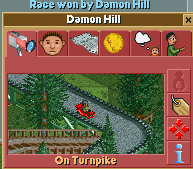 Damon Hill. Drives Go Karts at approximately two times the normal speed.
Damon Hill. Drives Go Karts at approximately two times the normal speed.
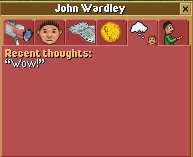 John Wardley. Thinks "Wow!" while riding on a ride.
John Wardley. Thinks "Wow!" while riding on a ride.
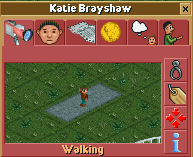 Katie Brayshaw. Frequently stops and waves.
Katie Brayshaw. Frequently stops and waves.
 Melanie Warn. Remains constantly happy and energetic.
Melanie Warn. Remains constantly happy and energetic.
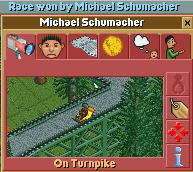 Michael Schumacher. Drives Go Carts at approximately one and one half times the normal speed.
Michael Schumacher. Drives Go Carts at approximately one and one half times the normal speed.
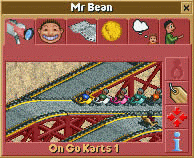 Mr Bean. Drives Go Carts at approximately half of the normal speed.
Mr Bean. Drives Go Carts at approximately half of the normal speed.
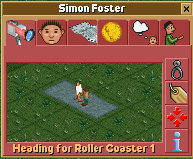 Simon Foster. Frequently stops and paints pictures.
Simon Foster. Frequently stops and paints pictures.
Yes, you can race both Damon Hill and Michael Schumacher together (I tried it). Because Damon Hill drives faster than Michael Schumacher however, the secret to a good race is to name someone further back in the starting line Damon Hill, while naming someone closer to the front Michael Schumacher. This way, Damon Hill will have to work his way through the pack, which will somewhat counteract his speed advantage.
There are 10 reportable activities (at the bottom of the guests information window) that guests will engage in, and which you can attempt to affect: At shop/stall; Heading/Queuing for ride/shop/stall; Leaving the park; Looking at scenery; On ride; Sitting on bench; Using the bathroom; Walking; Watching ride; Watching construction of ride.
The guests activities are linked to a number of changing motivations. The 6 Major motivations are Bathroom, Energy, Happiness, Hunger, Nausea, and Thirst, which can be monitored on a bar graph from inside the guests information window. These motivations are linked to a countdown timer, that increases/decreases the motivation level based upon the time since an outside force acted upon it. For example, if a guest eats, the hunger bar will decrease and then slowly increase until the guest eats again. The "Summarized" tab in the "Guest Info" window is useful for finding incipient park problems, as it lists the current thought and action of each park guest in decending order (so take note if any negative coments appear near the top).
Bathroom levels increase over time. When a guest uses a toilet, their Bathroom urge decreases and Happiness significantly increases. A guest will not attempt to use a toilet until he reaches a high enough bathroom level. Guest needing to use the bathroom will usually head strait for it. It is a good idea to have at least one bathroom for every 100 - 200 guests. Tip: Keep bathroom rental at $0.20 or less. Above this amount guests tend to 'hold-their-water' and complain.
Bathroom can be increased in the following ways:
A guests face icon will change ![]() when he gets tired. This icon will be displayed in preference to a Happiness icon. Energy levels very slowly decrease over time. Climbing hills does not appear to decrease Energy any quicker than walking on a flat path, however walking long distances between attractions {m} will slowly decrease a guests Energy level because such a guest is not encountering anything that would increase it. Energy level affects the speed at which guests move through the park. A guest with low energy level will shuffle along with his head hung down, slowing any other guest that enters the same square behind him. Tired guests are also less likely to want to do anything but shuffle down paths {m}, and thus they will miss opportunities to increase their Happiness.
when he gets tired. This icon will be displayed in preference to a Happiness icon. Energy levels very slowly decrease over time. Climbing hills does not appear to decrease Energy any quicker than walking on a flat path, however walking long distances between attractions {m} will slowly decrease a guests Energy level because such a guest is not encountering anything that would increase it. Energy level affects the speed at which guests move through the park. A guest with low energy level will shuffle along with his head hung down, slowing any other guest that enters the same square behind him. Tired guests are also less likely to want to do anything but shuffle down paths {m}, and thus they will miss opportunities to increase their Happiness.
A minor design goal of the game is to create a park that will increase the energy level of guests. Energy can be increased a number of ways:
Guests will only voluntarily choose to sit on an undamaged bench which they pass if their energy level is currently somewhere in Low (so benches for Energy restoration are needed less around high Excitement attractions). Sitting on the bench will begin increasing the guests energy level. Sitting guests will remain seated until their energy level rises to the very top of Medium, at which point they will leave the bench.
One of seven icons ![]()
![]()
![]()
![]()
![]()
![]()
![]() continuously indicate the happiness level of a guest. A major design goal of the game is to create a park that will increase the happiness level of guests. High happiness levels increase a guests probability of riding rides and acquiring items. Happiness levels decrease over time. A guest whose Happiness level falls so low that it starts to flash will soon cause the guest to think: "I want to go home", and they will then head for the park exit (note that even though they will leave, their Happiness can still be boosted on their way out). If a guest is happy when he finally leaves the park, he will tell his friends {s}.
continuously indicate the happiness level of a guest. A major design goal of the game is to create a park that will increase the happiness level of guests. High happiness levels increase a guests probability of riding rides and acquiring items. Happiness levels decrease over time. A guest whose Happiness level falls so low that it starts to flash will soon cause the guest to think: "I want to go home", and they will then head for the park exit (note that even though they will leave, their Happiness can still be boosted on their way out). If a guest is happy when he finally leaves the park, he will tell his friends {s}.
Happiness can be increased by design in a number of ways:
Happiness can be increased if the guest interacts with attractions in a number of ways:
Happiness can also be decreased a number of ways:
Trick - If you are having difficulty calming a vandal, create a "time out" box. This is an isolated (far from view of other park visitors) two-by-two paved area filled with benches, lamps, and trash cans. "Pincer" the vandal into this box and let him break things. When he feels better, "pincer" him back into (a pleasant portion of) the regular park area, and fix the damage in the "time out" box (or eliminate the box completely).
Hunger levels increase over time. Hunger decreases when a guest acquires food (but eating increases Thirst and [NOT TESTED] Nausea). A guest will not attempt to acquire food until he reaches a high enough hunger level. A guest must take time to consume food, and will prefer to sit on a bench to eat. When finished eating, guests will normally toss food wrappers on the ground (any guest viewing the trash afterwards may comment negatively) unless they have access to an empty litter bin within [NOT TESTED] 3 squares of their direction of travel from their current location. As guest Nausea will diminish over time, it is a good idea to place food stalls some distance from a nauseous ride (and for that matter, to separate two nauseous rides from each other), because a sick but hungry guest will foolishly seek out a food stall (and then vomit).
A guests icon will change when he gets sick ![]() or very sick
or very sick ![]() . Nausea levels decrease over time. Guest with a high nausea level will desire to sit on a bench or consume a drink. If the level is too high, they will also vomit
. Nausea levels decrease over time. Guest with a high nausea level will desire to sit on a bench or consume a drink. If the level is too high, they will also vomit ![]() . Surprisingly, guests who are allowed to vomit will see a slight decrease in their nausea level (however any guest viewing the vomit afterwards may comment negatively).
. Surprisingly, guests who are allowed to vomit will see a slight decrease in their nausea level (however any guest viewing the vomit afterwards may comment negatively).
Nausea will be increased in a number of ways:
Thirst levels increase over time. Thirst and [NOT TESTED] Nausea decreases when a guest acquires a drink (but drinking increases Bathroom). A guest will not attempt to acquire drink until he reaches a high enough thirst level. A guest must take time to consume drink, and will prefer to sit on a bench to drink. When finished drinking, guests will normally toss drink containers on the ground (any guest viewing the trash afterwards may comment negatively) unless they have access to an empty litter bin within [NOT TESTED] 3 squares of their direction of travel from their current location. Note that high Nausea increases Thirst, so it is a good idea to place drink stalls near the exit of nauseous rides (guests do not vomit drinks).
Thirst can be increased in a number of other ways:
Each new guest arrives with a fixed "Preferred Ride Intensity" and "Nausea Tolerance". These two settings appear to be separately generated (so for example a person with a desire for high ride intensities could have a weak stomach). Regardless, most new guests entering the park appear to prefer riding something other than a Gentle ride as their very first ride (a guest "steering" consideration when designing the area near the park entrance). Also guests with a wide Intensity tolerance appear to prefer to experience one relatively lower Intensity ride before they will allow themselves on a relatively higher Intensity one. Ultimately, guests will only use rides they "know" exist.
The game appears to have a pool of pre-defined intensity choices from which a Preferred Ride Intensity Preference is randomly selected for a new guest. These selections consist of a range of intensities (rather than a single number), with the narrowest being a range at least three Intensity levels wide. Note that the pre-defined patterns are a mix of "greater-than / less-than" along with "fixed" range intensity numbers. Although a random selection would normally form a linear pattern, the pre-defined ranges force a bell curve pattern.
I examined 700 guests that had entered one of my parks, and created a chart showing what percentage of the parks guests would be likely to choose a ride of a specific Intensity:
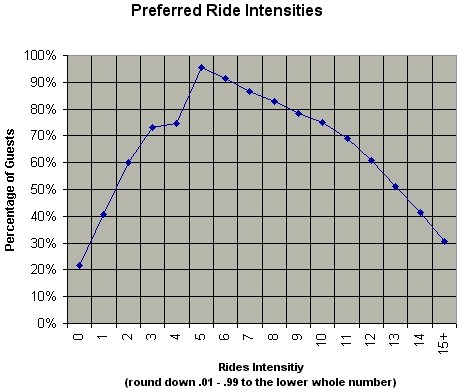
On the left of the chart is the percentage of the 700 guests that would be willing to go on a ride of a specific intensity, and on the bottom of the chart is a whole number intensity for a ride. Because the guests Preferred Ride Intensity is a range, they are equally likely to choose any of the rides within their preference, so each guest was plotted more then once. For example, a guest with a range of 3-6 would be plotted under 3, 4, 5, & 6 and a guest with a range of 'less-than' 5 would be plotted under 0, 1, 2, 3, & 4. Note that a large amount of ultra high Intensity preferences are an artifact due to the 'greater-than' qualifier. The notch appearing at Intensity levels 3 & 4 also appears to be a qualifier mixing artifact.
Examination of the ![]() spreadsheet indicates that even your wimpiest guests can go on rides with an intensity of up to 2.99. The greatest thrill seekers however will avoid rides that don't have a minimum intensity of at least 5.00. Note that the 'notch' Intensities of 3.00 - 4.99 falls exactly between the greatest wimp and thrill seekers preferences. As guests will avoid riding on a ride that falls outside their Intensity Preference, patronage of Transport rides can be affected. If necessary, you may have to create a "roller-bus" (a multi-station side-friction wooden roller coaster in the form of a "scenic railway" is an excellent choice) to transport your thrill seekers.
spreadsheet indicates that even your wimpiest guests can go on rides with an intensity of up to 2.99. The greatest thrill seekers however will avoid rides that don't have a minimum intensity of at least 5.00. Note that the 'notch' Intensities of 3.00 - 4.99 falls exactly between the greatest wimp and thrill seekers preferences. As guests will avoid riding on a ride that falls outside their Intensity Preference, patronage of Transport rides can be affected. If necessary, you may have to create a "roller-bus" (a multi-station side-friction wooden roller coaster in the form of a "scenic railway" is an excellent choice) to transport your thrill seekers.
I had not expected such a large percentage of guests who prefer ride intensities of 10+. This could be an issue, since the Excitement rating of a ride falls off dramatically when the rides intensity becomes 'Extreme'. Note that every time a guest completes a ride without getting sick, the guest's current Intensity preference will [NOT TESTED] increase by one, until their Intensity range limit maximum is reached. This supports the tip of placing lower intensity rides near high intensity rides, so guests have an opportunity to 'build-up' to the more Intense rides {s}.
Based on this chart, I suggest that Ride Intensity be kept between 2.00 and 10.19 (actually 12.99, but the reduction is due to the ride Excitement rating drop factor at 10.20). I further suggest that one low priced ride between exactly 1.00 - 2.99 intensity and one ride between exactly 5.00 - 5.99 intensity be placed near the park entrance gate, to assure that 100% (based on examination of the 700 guest survey) of your NEW guests will have the opportunity to go on at least one ride in your park (the lower intensity ride addresses the "_ looks too intense for me" comment and the higher intensity ride addresses the "I want to go on something more exciting than _" comment). Better still, make these two rides "covered rides", so guests could use them even in the rain!
I examined 700 guests that had entered one of my parks for nausea tolerance. The results were 69 with None, 178 with Low, 286 with Average, and 167 with High. Compensating for statistical error, this chart illustrates the resultant bell curve:
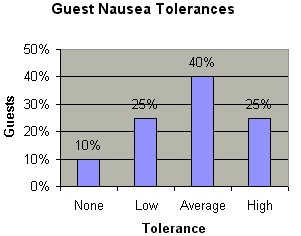
This next chart show the assumed correlation between Ride Tolerance and Ride Nausea Rating. On the left is the percentage of the 700 guests that could become ill due to the rides Nausea Rating, and on the bottom is Nausea Rating for the ride. Note that on a ride with an Nausea Rating greater than High all guests Nausea Tolerance is exceeded, so every guest has a possibility of becoming ill:

Note the large jump between Average and High nausea rides. I suggest therefore that to limit the possibility of your guests becoming ill, you limit your rides Nausea Ratings to Average or below (guests tend to under estimate their nausea tolerance, although if the separation is too great they may comment that "Just looking at _ makes me feel sick"). Nauseas guests do not generate revenue for your park, and their vomit has potential to lower your parks ratings.
Park Rating + Park Value = number of park guests.
Park rating is a number between 0 and 1000, and reflects the guests' overall impression (of ride design, park layout, tidiness, value, efficiency, etc.). The majority of Guests will enjoy a park that has a Park Rating over 600 {s}. If the Park Rating begins to slip, you can usually discover the reason by examining your Guests comments (from the Guest Information button on the main toolbar).
Advertising will affect the actions of new guests who enter the game during the advertising period (and may also increase the number of guests arriving). The new guest will usually attempt to take advantage of an advertised attraction by heading straight for it when he enters the park. Guests heading strait for an attraction will become confused if a path forces them away for too long a period from the compass direction of the attraction they are heading for.
Weather can sometimes be used to an advantage (such as when choosing types of food/drink stalls). When it rains, guests will open their umbrellas if they have them. Many guests without umbrellas will attempt to immediately acquire one. Most guests will also avoid entering queues for rides that are not considered "covered" rides, and will try to quickly get into a queue for one that is. Guest will pay more to buy an umbrella or ride on a "covered" ride while it rains (so if you are a particularly greedy micro-manager, watch the weather icon and then jack up prices just before it rains). One trick to get Guests into distant or poorly traveled places in your park is to put a shop selling umbrellas (and/or a covered ride) in that location, as Guests will at least travel to that area when it rains. Tip: Differ the color of identical items sold at each stall, so you can easily monitor where that item came from.
Rides upon which an accident occurred or rides that have not been tested will not attract guests. Guests know the safety ratings of rides and will make a judgement to ride based upon them (see "Ride Motivations" above). Guests will become increasingly unhappy, and will eventually even step out of the queue, if the wait for an open ride is too long. Scenery, Entertainers, and other tricks can help slow the happiness reduction.
A guest will not enter the park, acquire a item, or ride on a ride if they consider the price too high. Price also effects the facilities "Satisfaction" level for guests. Guests are less willing to pay for rides that are older or have lower excitement ratings. When a guest runs out of money, he will leave the park. Don't overlook manipulating guests by pairing attractions. For example, salty food will make a desire for a drink more probable and an exciting ride will increase a guests desire to purchase a souvenir. Only one item of each type will appear in the guests Inventory window, and it appears that once they have that item type in their inventory they will not purchase a duplicate. Randomly guests may loose an inventory item, but that doesn't appear to affect their stats (beyond not having the item) or make them want to replace it more/less. Food and drinks are consumed quickly after acquisition, while the guest is either walking or sitting (they will often choose to sit at an unvandalized open bench they pass). Up to two guests can use a bench (making a theoretical limit of six sitting spots on a path tile). Only one food item (which lowers the Hunger stat) or drink item (which lowers the Thirst stat), and not both types, may be consumed at a time, so it is more sensible to space these stalls around the park rather than grouping them in a "food court". Since some foods increase thirst (and drinks increase bathroom), it would be ideal if a guest walked past those stalls in that sequential order.
Guests have only a limited knowledge of the park (distance not yet determined), which is why you must place observation points and paths near facilities in order to make them 'aware' of the facilities existence. Elevated rides allow your guests to see other rides and areas of the park, which can spark interest in visiting them {m} (height to distance ratio not yet determined). A guest possessing a Park Map only doubles his knowledge, but maps do help guests determine which ride to go on next (whether determination is limited to the "knowledge" zone, or includes the whole park, is still to be determined). Guests will become "lost" if they travel long distances without encountering entrances to attractions, so plan your park layout carefully. While it is a good idea to have an Information Kiosk near the park entrance, it is better to situate it no closer than where the park entrance path first starts to diverge. Up until that place there is not a large need for a park map, and this placement also keeps the guests wanting its umbrellas deeper in the park.
A guest will blindly continue down a path until he reaches an intersection (or passes an entrance to an attraction). If a path turns 90 degrees the guest will continue walking forward along the turned path. If a path dead ends, the guest will make an about face and walk back the way he came. If the path forms a "T" or "+", the guest will randomly select one of the forward directions (right, left, or to a slightly higher probability straight as appropriate). Be aware that each square of a double (or greater) wide path acts like a "T" (or "+") intersection, and can cause your guests to spin around in circles. Marking one of the branching paths with a sign seems to increase the probability of a guest (but not Staff) selecting that path. Conversely if the sign is a "NO ENTRY" sign, then a guest (but not Staff) will never enter the marked path (the guests actions are as if the path connection doesn't even exist).
Unless the guest is in the process of heading for the Park Exit (if they are, they are done, so you might as well help them there with the "pincers") or to a specific attraction (note that guests drawn into the park due to Marketing will have a predetermined desire to visit the advertised attraction first); if a guest passes an Entrance to an attraction (ride/shop/stall), he will make a choice about using the attraction or continuing along the path. If there are two attractions on each side of a footpath tile, he will randomly ignore one and choose between the other and the path. If there are three attractions on a footpath tile, he will randomly ignore two and choose between one and making an about face to walk back the way he came. It is usually best therefore to only put one attraction Entrance on a footpath tile (a Ride Exit Building or No Entry path is fine).
If there is a Bench on the same footpath tile as an attraction Entrance, a guest with low Energy may choose to use the bench over accessing the attraction. This is a good reason not to have a bench on the same footpath tile as a food/drink stall. Litter Bins could be placed here, but note that they are only used by Walking guests, and not by a guest patronizing a stall on the same tile as the litter bin until that guest has left the tile (making placing the bin on the next tile or beyond a superior decision). The best path item to place on a footpath tile with an attraction Entrance would thus be the Lamp.In the case of a shop/stall, the guest may change his mind after walking up to the counter and not use the facility (similar to a guest who changes his mind about an overpriced ride), even if the shop/stall is priced FREE. When the guest turns away from a shop/stall (whether he used the service or not), he will randomly choose a new direction to walk. Because of this effect, it is suggested that shops/stalls (or overpriced rides) not be placed too close to the Park Entrance, so guests will initially tend to travel a few more footpath tiles deeper into the park before opting to turn around (this early stretch of park entrance/exit path is a smart place for delightful Happiness boosting scenery). To maximize exposure to an attraction impelled to be on a dead-end footpath (dead-end footpaths longer than 4 tiles total should never initially branch from the main path in a direction running towards the park Exit), you may want to continue the (ideally short) dead-end path length a single tile beyond the attraction entrance. If the guest chooses to continue on the dead-end footpath instead of using the attraction, he will be forced to make an about face in that tile (tip: a good place for a food stall bench) and reenter the previous tile with the just passed attraction entrance, and thus again be faced with a choice about using the attraction.